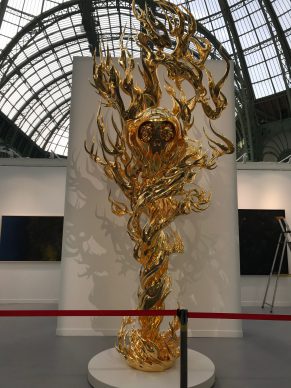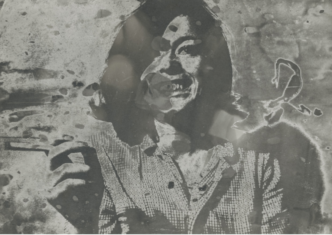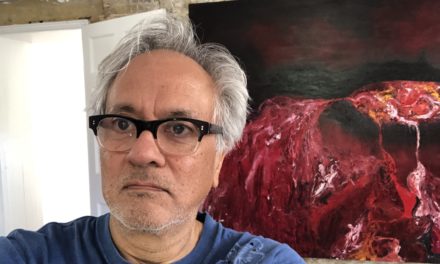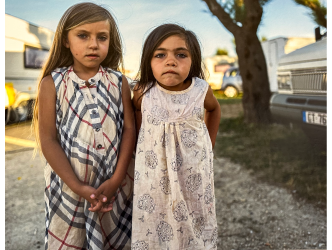Anish Kapoor likes his work to be really, really big, but people often ignore the fact that he also creates piecesworks on a modest scale. He receives media attention for his smooth and shiny sculptures in various plastics and polished steel, but he also enjoys producing dirty, trashy work by accumulating layers of color paint, heaps of cement and oodles of grease.
Anish Kapoor spent his entire youth in noisy, filthy Mumbai, but his upper -class– inflected British accent and his title of Commander of the Order of the British Empire have earned him the title ofright to be called “Sir.” Anish Kapoor is one of the world’s most famous artists, but in the end he is a total stranger. Perhaps because this affable man with a smile always at the ready doesn’t have time to talk. Or very little.
But from now on Anish Kapoor is France’s darling. Beginning June 9, he’s setting up residence in yet another French space renowned for its spectacular contemporary art projects: Versailles. He’s placed four outsize sculptures in the chateau’s park, and a fifth at the Jeu de Paume in the center of town. The event promises to be extraordinary, generating many oohs and aahs from the public. And Kapoor likes that. The passionate Jean de Loisy, the passionate head of Paris’s Palais de Tokyo who speaks of Anish as his “brother,” describes the artist’s goal: “His passion is to organize material things so they acquire a spiritual aspect. He enjoys creating a feeling of vertigo but he doesn’t want to impart any mystical message. He just wants to organize matter up to a certain level of perfection.”
Kapoor’s ideas lab is located in the south of London, in an immense workshop fashioned from a series of little houses bought over time in the same street, where some twenty people work for him. “It’s buzzing like a bee’s nest, with constant research and a way he has to relentlessly pick his mistakes apart until they yield something fruitful,” Jean de Loisy explains, stressing the artist’s ability to renew himself.
A number of large cities have received the Kapoor’s seal. In Chicago, for instance, one of the city’s main attractions, the place where tourists like to have their picture taken, is a sort of enormous polished-metal bean, the artist’s Cloud Gate, weighing in at a cool 110 tons (100 metric tonnes), which both deforms and reflects everything around it, creating a troubling illusion. In the famous Turbine Hall at London’s Tate Modern, Kapoor had created a 508-foot-long (155-meter-long) resin structure in the shape of a trunk, as well as and other welcoming forms. In the same city, Kapoor was selected to build the emblem of the 2012 Olympics, the ArcelorMittal Orbit tower, a 377-foot-high (115-meter-high) metal coil from which visitors could see an exceptional panorama. A sort of 21st-century Eiffel Tower that induces vertigo as well as an illusion of instability.
Alfred Paquement, the former director of Paris’s Musée National d’Art Moderne (otherwise known as Centre Pompidou), is the curator of the Kapoor exhibition in Versailles. He too notes the range of subtle contradictions within the artist’s work: “His pieces are always complex. There’s a play between what’s shown and what’s hidden, between emptiness and fullness. People have trouble grasping the breadth of it at first sight.” As an example, he points to the piece that will be shown at the Jeu de Paume: a cannon firing masses of red matter at a wall across the room. The result: an abstract painting. “In such a location, the piece opens up multiple interpretations,” the expertPaquement continues: “The cannon is the ultimate phallic principle.” The curatorPaquement adds that no woman is represented in the David painting exhibited in this room, which depicts a famous French revolutionary oath-taking scene. On another occasion, Kapoor has said that at the beginning of his career, people often mistook him for a woman because of his first name, which pleased him. Might Sir Kapoor be a feminist?
If this is the case, he’s fighting the same battle as Julia Kristeva, the famous psychoanalyst with whom he has a long exchange in the catalogue that accompanies the Versailles exhibition. “He’s a keen reader of Kristeva’s books and very much interested in psychoanalysis,” Paquement says by way of explanation. Without playing amateur psychoanalyst, we can still note that Kapoor’s childhood may provide the beginning of an elucidation to thefor the enigma that is the artist.
Young Anish wasn’t an not Indian boy like all the others, and as a result his work doesn’t bear any trace of the country’s exuberance and chaos. Kapoor’s life was divided between two communities, and he himself has declared feeling like “a stranger everywhere.” A Jewish woman with Iraqi origins, his mother spent her time within the local community, while his Indian father had a career that most certainly influenced the youngster’s imagination: he was a hydrographer. In other words, he drew the ocean floor by hand (still, at the time!) for the country’s navy. When the artist speaks about his father’s work, it’s as if he were evoking his own creations: “It’s a relationship to endlessness, to depth. It’s an abstraction based on science, on precise dimensions.”
Kapoor’s Paris dealer Kamel Menour insists, in his description of him as a person, on the artist’s extraordinary precision, his “extreme meticulousness,” and his being “in a permanent quest for perfection.”
You don’t need to be a psychoanalyst to know that a quest for perfection is a source of dissatisfaction. When a BBC journalist askeds Kapoor whether for him today the glass wasis half full or half empty for him today, the artist, now at the peak of his career, replieds: “Half empty, because a lot of work remains to be done.”
Yet, as he says so himself: “I am tremendously lucky. I am an artist. In other words, what I’m asked to do everyday is to do exactly what I want. Simply put, I’m exploring my inner life and allowing others to see it in one particular shape.” At Versailles, his inner life takes the shape of a paint cannon, a powerful whirlpool, a giant trunk set in the landscape—along with other outsize empty and full spaces that deal with poetry and mythology. André Le Nôtre, gardener to the Sun King, would appreciate that.
Support independent news on art.
Your contribution : Make a monthly commitment to support JB Reports or a one off contribution as and when you feel like it. Choose the option that suits you best.
Need to cancel a recurring donation? Please go here.
The donation is considered to be a subscription for a fee set by the donor and for a duration also set by the donor.









